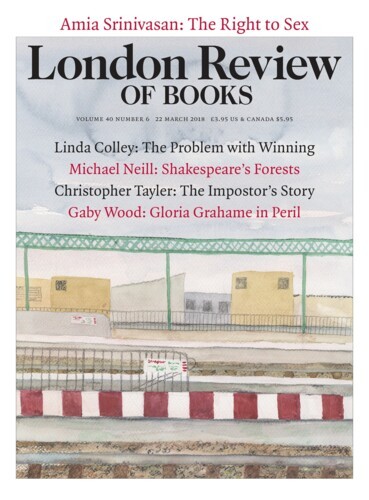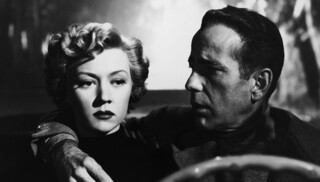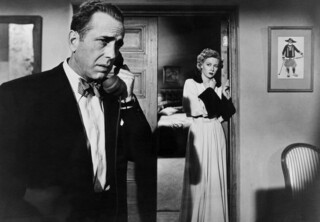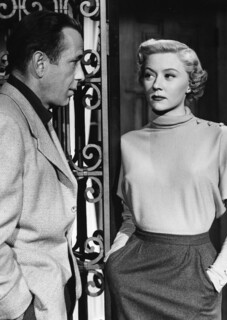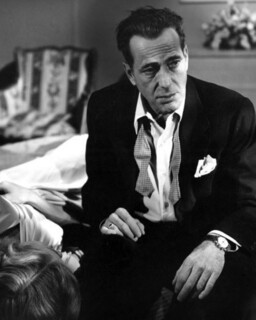What does it mean for a romance to take the shape of a murder investigation? In a Lonely Place, Nicholas Ray’s elegantly bitter film about damaged trust, throws that question at its viewers. If all love stories are inquiries of one kind or another, the movie seems to suggest, perhaps they differ only in their relative violence. When filming began, Ray was married to its female lead, Gloria Grahame; by the time it ended, they were living apart. Ray said it was ‘a very personal film’ – and as parting gifts go, it was both poisonous and immortal.
The book on which the film is based – a noir novel written in 1947 by Dorothy B. Hughes – is told from the point of view of a serial strangler named Dixon Steele. We know from the outset that he is guilty; what we don’t know is whether he’ll be caught, and, if he is, how many women he will have killed in the meantime. Hughes, one of very few female crime writers in the noir canon, made it clear that she intended to sidestep the whodunnit in favour of character, and here her focus is on the ways in which women might be seen by a man who ritually kills them. They are viewed through Dix Steele’s eyes as ‘cheats, liars, whores’, and presented by Hughes as perceptive and tough. Though the crimes are technically solved by an astute male detective, the women are on to Dix first.
Hughes had been writing novels throughout the 1940s, and regularly wrote about crime fiction. She lived in Santa Fe, but did a brief stint in Hollywood in 1944, when she worked as an assistant to Hitchcock on the set of Spellbound. There she met Ingrid Bergman, and as a result when In a Lonely Place was published, Bergman’s friend Humphrey Bogart bought the rights for his own fledgling production company.
The action essentially takes place in the mind of the character Bogart saw as a part for him to play. Hughes’s novel, her best known, was an early and influential example of the ‘psyche of a serial killer’ form. (The idea is that a murderer can never escape what he’s done – he’s ‘caught there in that lonely place’, as one character puts it. ‘He has to live with himself.’) Although it’s usually said that the film retains nothing of the book beyond its title, its setting and the names of its characters, in this fundamental respect – the concern with Steele’s habits of thought – they are related. In Bogart’s rendition, the possibilities of the plot were sprung open. Steele was no longer a guilty man – just a man who looked guilty, or looked like he felt guilty.
In one of the best seduction scenes in cinema, an interrogation becomes a flirtation: third-person, no eye contact, refracted through the cops’ questions. The setting is the office of Captain Lochner in Beverly Hills police station. The language is the language of evidence. Dix Steele, a Hollywood screenwriter, has been called in over the murder of Mildred Atkinson, a girl he was with the previous evening. We’ve already seen Bogart-as-Dix take little interest in Mildred, whose job was to tell him the plot of a terrible novel he’d bleakly agreed to adapt, and here he takes no interest in her murder either. Lochner sees Dix’s indifference as incriminating – his response to the news, the policeman says, is ‘just petulance. A couple of feeble jokes.’ Dix doesn’t let up. ‘I grant you, the jokes could have been better, but I don’t see why the rest should worry you.’
Enter his alibi: Laurel Gray, a neighbour who saw him come home with Atkinson. At the threshold of the captain’s office she raises an eyebrow, just slightly, and over the next few moments it becomes clear that, for the purposes of irascible romance, Dix and she are the same person: unintimidated, less than ingratiating, sarcastic. She sits down, peers into a near-empty cup of coffee, looks up. Words are unnecessary: she’s nobody’s suspect; men have no manners.
‘Miss Gray, do you know this gentleman?’
‘No.’
‘Did you ever see him before?’
‘Yes, a few times.’
‘Where?’
‘At the patio apartments. We both live there.’
‘Do you know who he is?’
Her back is to Bogart. He has one foot up on the leather sofa, arm resting nonchalantly on his knee. Though he’s sitting behind her, the depth of field is at a maximum, so that they are in almost equal focus. The implication of the framing is clear: throughout this scene, though they say nothing to each other directly, the dialogue is between them.
‘Yes,’ Grahame replies. ‘When I moved in a few days ago, he was pointed out to me by the manager. She was very proud of having a celebrity for a tenant.’
Her arched brows are doing their subtle work. The irony is meant for the man behind her.
‘Did you see Mr Steele last night?’
‘Yes, as I came home I saw him go into his apartment with a girl.’
‘That girl was Mildred Atkinson. She was murdered between one and two o’clock this morning.’
Grahame turns to face Bogart for the first time. She moves slowly, without shock. But vulnerability, and something like affront, enter her eyes. He returns her gaze plainly. She turns back. ‘Murdered?’ she says.
The ending is in this beginning. She registers that he may be a killer. Does she believe in his innocence? Not necessarily. Can she handle him? Perhaps. Or can she not handle him – and does that make him her kind of guy? She continues to respond, undaunted.
‘Were you interested in Mr Steele because he’s a celebrity?’
‘No, not at all.’ Her gaze is impassive. ‘I noticed him because he looked interesting. I like his face.’
Steele smiles. Gray is dismissed. She leaves without looking at him again.
The film is built on Bogart’s face: its crumpled anger, its tombstone teeth, everything registered on his forehead when he lights a cigarette: defeat, bewilderment, sorrow at the predictability of everything. (‘Keep it in the shadows, Gloria,’ Bogart advised Grahame on set, ‘Let the camera come to you.’) Ray credited himself with ‘taking the gun out of Bogart’s hand’ – meaning he steered him away from the gangster roles he’d always played and brought him into the territory of complex characters. We know from Bogart’s face that Dix has murdered his own life, and we are beginning to understand that he is a serial killer. He starts brawls in bars, he breaks his lovers’ noses, he has fistfights with producers. Later in the film he smashes his agent’s glasses and almost kills a motorist in a random fit of rage. Whether or not he has strangled Mildred Atkinson, he’s capable of killing someone, and that, ultimately, is the knowledge on which the romance must rest. Can he be trusted? The engine of the film is fear: not the fear triggered by a murder, though that is the model it offers, but the fear of more intimate, ongoing forms of harm, and of the ways in which people might invite it.
In Hughes’s book, Dix’s misogyny derives from a paradise lost. The novel is an intentionally restricted response to the colossal trauma of the Second World War. Dix is an emasculated war hero, a man at a loss, without an income, masquerading as a novelist and living off hand-outs from his uncle – who suggests, when Dix says he needs medical attention, that he visit the ‘veterans’ hospital’. As the crime writer Megan Abbott writes in the afterword to this edition of In a Lonely Place, ‘Hughes understood implicitly how such trauma connects to gender and a dangerously beset masculinity – and how it can explode into sexual violence.’
‘The war years were the first happy years he’d ever known,’ Hughes writes of Dix. Laurel is ‘the only right thing he’d had since he took off his uniform’. We discover that Dix initially uses the war as his cover: ‘There’d been so much killing, one more wasn’t news.’ And Hughes gives him an alter ego in the form of an old wartime pal: Brub Nicolai, a fellow ex-soldier who has become a policeman with the LAPD. If Dix’s mind is the book’s subject, his mind games take up a large part of it. Brub is hunting down the killer, who he doesn’t realise is in fact his friend. Remembering the war, Brub tells Dix:
I don’t like killing. I saw too much of it, same as you did. I hated it then, the callous way we’d sit around and map out our plans to kill people. People who didn’t want to die any more than we wanted to die. And we’d come back afterwards and talk it over, check over how many we’d got that night. As if we’d been killing ants, not men.
It’s clear that each of these men stands for a fork in the postwar path: one becomes a cop, a man in search of an antidote; the other becomes a killer, exchanging the work they began together for a solo career.
In the film, the war is referred to but only to imply a certain old-boy loyalty – Dix, we’re told, was Brub’s commanding officer – yet early on, Dix is mocked by movie people in a bar because he hasn’t ‘written a hit since before the war’. There’s something missing: what the war did to Dix. Years of authorised killing are elided, but they’re there, like a residue left by Hughes’s desire in her novel to understand what happened to the men.
In order for us to see what the film is up to, it’s essential for the murder victim to be irrelevant. If the audience cares too much about Mildred, we’ll fall for the idea that we’re watching a whodunnit, and fail to see the point of the broken romance. The film manages this by giving Mildred a metaphorical as well as a literal role: she is the agent of cliché. ‘I think it’ll make a dreamy picture, Mr Steele,’ she says of the trashy novel she’s been asked to describe, hours before her death: ‘what I call an epic.’ To judge from Bogart’s expression, her belief in banality might be motive enough.
Cliché isn’t Ray’s own mode, it’s the main signal of weariness in the mind of the hero, and so contributes to the film’s caustic tone overall. In a Lonely Place sets you up to see the world through Dix’s eyes – and achieves something more than sympathy: an instant affinity with his ennui. When Dix has dinner with Brub and his wife, Sylvia, he entertains them by envisaging the murder scene. ‘Tell you what’s wrong with you and Lochner,’ he says to Brub: ‘You don’t see enough whodunnits. We solve every murder in under two hours.’ He gets them to re-enact what he thinks might have happened, and Sylvia becomes frightened. When Dix has left, she turns to her husband and says, appreciatively: ‘I’m glad you’re not a genius.’ But she has misidentified Dix’s problem. It isn’t that he’s brilliant but that he’s bored. He’s been working in Hollywood so long that he’s heard every story there is, and he doesn’t think life is any more generous with surprises.
In the corridor of the police station, Dix is introduced to Henry Kesler, the suave banker who’d been dating the dead girl. ‘They trying to pin this thing on you too?’ Dix asks, as cheerfully as his laconic nature will allow. ‘Matter of fact, you’re a much more logical candidate than I am. You were in love with her. You could have been jealous. If I were Captain Lochner I could build up a pretty good case against you.’ He extends his hand, and smiles. ‘Glad to have met you.’ Kesler shakes Dix’s hand. ‘What an imagination,’ Kesler says, uncomfortably. ‘That’s from writing movies.’
In other words: one of the possible plots shuffling through Dix’s head is bound to be right. This sets the film apart from the book in two ways: it makes the movie, emphatically, a movie about the movies; and it makes the plot even more inconsequential. The film’s purpose must lie elsewhere.
‘We solve every murder in under two hours’: something else is happening here. Speed is integral to the story: the whirlwind love affair, the swift disintegration of Dix’s mind. ‘I don’t like to be rushed,’ Laurel tells Dix the day they meet. The line is echoed at the end, when Dix asks her to marry him and she replies that they needn’t rush into anything. ‘Who said anything about rushing into anything?’ he counters. ‘I thought maybe if you give me an answer, say in the next ten seconds, I’d go right out and buy a ring.’ When Dix refers to the fact that screenwriters can solve murders faster than policemen can, he is giving movie time – speeded-up time, flash-forward time – as the measure of the story within the film. Things – murder investigations, romances – that would otherwise take months or years are accelerated. After a violent row, Dix murmurs a few lines he wants to put into the script he’s writing: ‘I was born when she kissed me. I died when she left me. I lived a few weeks while she loved me.’ The phrase is later repeated, melancholically, as if its main significance were the rhythm. But listen again and it’s all about hurry. What is the hurry? This: redemption isn’t something that happens at the end – it’s a constant emergency. The film’s atmosphere of anxiety, and Dix’s own coerciveness, can be traced along these lines: time itself must be subject to his violent control.
Nicholas Ray met Gloria Grahame when he cast her in A Woman’s Secret, shot early in 1948. Maureen O’Hara was the star; Grahame, a 24-year-old RKO contract player who had just been nominated for an Oscar for Crossfire, played a young singer (though she didn’t sing herself). By 1 June, when Ray and Grahame married in Las Vegas, she was four months pregnant with their son Tim.
When Bogart bought the rights to Hughes’s novel, he imagined Lauren Bacall for the role of Laurel Gray. The couple had already made four films together –To Have and Have Not, The Big Sleep, Dark Passage and Key Largo – but Bogart had since left Warner Brothers, and Jack Warner, who still had Bacall under contract, wouldn’t release her. Ray, meanwhile, was on loan to Columbia, and couldn’t cast his own wife either, because she was still at RKO, which was run by Howard Hughes. (The Rays and the Bogarts were friendly; their baby boys had been born a few months apart.) Harry Cohn, Columbia’s bullying boss, began to get impatient over the filmmakers’ seeming inability to cast the female lead. ‘I hear you’re having a problem with the leading lady,’ Cohn is supposed to have said to Ray. ‘I don’t have a problem,’ Ray said. ‘I just don’t want Ginger Rogers.’ (He meant the real Ginger Rogers, who was on offer, though it might as well be a catch-all term for the opposite of a femme fatale.)
‘Who do you want?’
‘Gloria Grahame.’
‘You’re married to her, huh?’
‘What the hell does that have to do with it? She’s right for the part.’
After some gangsterish shenanigans involving Cohn and Hughes meeting at a filling station in the middle of the night, Grahame got the job.
As it happened, their being married had quite a lot to do with it. It was widely reported that Grahame’s contract contained a ‘Mr and Mrs’ clause, which allowed her husband to ‘direct, control, advise, instruct, and even command my actions during the hours of 9 a.m. to 6 p.m., every day except Sunday, during the filming’. She was forbidden to ‘nag, cajole, tease, or in any other feminine fashion seek to distract or influence him’. She agreed that ‘in every conceivable situation his will and judgment shall be considered superior to mine and shall prevail.’ Even so, Ray moved out of their home. He told the producers he was having trouble with the third act and wanted to work through the night; they built him an apartment out of two dressing rooms.
It was true that he had trouble with the third act – or, specifically, the final scene. At first he shot it as written. Then he devised an alternative. As the film spirals to its conclusion, Gray attempts to get away from Dix. ‘I’m scared of him. I don’t trust him. I’m not even sure he didn’t kill Mildred Atkinson,’ she tells Dix’s agent. She agrees to marry him but as soon as he’s left her apartment she buys a ticket to fly east. She hands the screenplay Dix has finally finished (and which she has typed) to the agent, in the hope that its success will take his mind off the fact that she is missing. But he senses her withdrawal, goes to her apartment and notices she’s not wearing the engagement ring he’s just bought her. Her phone rings. He picks up. It’s the travel agent, calling to say there’s a seat on an earlier flight to New York. ‘You run away from me the first chance you get!’ he growls, clutching her throat. ‘Don’t act like this, Dix! I can’t live with a maniac,’ she protests, before he pushes her onto the bed and starts to strangle her.
In version one, Dix finishes the job. The next morning Laurel is dead and he is arrested while sitting at his typewriter adding the final lines to a screenplay we might imagine is the basis for the movie we’re watching, or something like it. After he’d shot the scene, Ray thought better of killing off his wife. ‘Shit,’ he later remembered thinking, ‘I can’t do it, I just can’t do it! Romances don’t have to end that way. Marriages don’t have to end that way, they don’t have to end in violence. Let the audience make up its own mind.’
In version two, the ending used in the final film, the strangling is interrupted by another phone call. This time it’s the police. Kesler has confessed, and Captain Lochner apologises to Dix for the strain he’s suffered and asks to say sorry to Gray. Moving slowly and groggily, beleaguered by his own violence, Dix leaves the receiver for Laurel. ‘Man wants to apologise to you,’ he croaks. He means Lochner, but also, perhaps, himself. The scene becomes a bookend to the original seduction in the police station. Again, Laurel speaks to the detective but directs her words at Dix. ‘Mr Steele’s absolutely in the clear,’ the police captain tells her, and she replies, rubbing her throat and staring at Dix, who is standing on the threshold about to leave: ‘Yesterday, this would have meant so much to us. Now it doesn’t matter. It doesn’t matter at all.’
What difference does knowing there were two endings make? Well, to begin with, it may seem surprising that the resolution in which Bogart is revealed to be the killer was the original, accepted one – except that everyone knew that from the book. As it happens, Production Code officials were against his being portrayed as a psychopath, and would only agree to the star playing a murderer if his character was seen to have been provoked. Bogart’s co-producer, Robert Lord, brokered the agreement: Bogart wouldn’t play a serial killer. He’d be a suspect, but someone else would be found guilty of those murders. However, he would crack under the pressure of suspicion and end up murdering his girlfriend. So in one interpretation of the jettisoned ending, Bogart and Grahame play a perfect couple caught in the jaws of the system. Superficially, this is a more brutal result, but it’s also a conventional one. The unconventionality of the eventual ending used – its painful nuance and drastic suspension – makes it more sinister.
Kesler’s confession, with its confirmation of Dix’s innocence, isn’t just an alternative ending. An ‘alternative’ would suggest that one thing mattered more than another. This shows that nothing matters, because the plot is not the point. The point is danger – and corrosion – in human relations. Kesler did it, but so what? – we knew Mildred was a MacGuffin. Meanwhile, the invisible yet palpably simmering thing has boiled over: Dix has lost control; any semblance of trust has vanished. This, masked all along by a detective story, rises to the surface in the final scene, as if a wound or a scar had been revealed rather than a murder solved.
The last-minute amendment, partly written by Ray and partly improvised by the actors, is what turns the film into a masterpiece. It’s the scene that shows you were living in the wrong story, the scene that makes film noir evaporate. The solution to the crime can’t resolve the romance. What good is a confession when all is lost?
Ray would go on to say of his marriage to Grahame: ‘I didn’t like her very much. I was infatuated with her, but I didn’t like her very much.’ As if in homage to Ray’s dislike, his biographer Patrick McGilligan refers to Grahame several times as a ‘sexy blonde actress’, and writes that ‘many of those who knew Grahame considered her a nymphomaniac.’ It wasn’t just those who knew her. In Peter Turner’s succinct, sad memoir, Film Stars Don’t Die in Liverpool (recently made into a film with an uncanny Annette Bening in the lead), Grahame is a washed-up Hollywood star about to die of cancer – but hers is a complicated decrepitude. Hair matted, make-up mouldering, asking to be ‘burped’ like a baby, she is even so billed in British repertory theatres as ‘the girl who can’t say no’.
McGilligan reports that Ray hired a private detective to follow her, because he suspected that, among other things, she was ‘bedding one of the elephant trainers she’d met on the set of Cecil B. DeMille’s The Greatest Show on Earth’. The elephants are pretty good (and the DeMille reference helpfully evokes not just one lover but an entire crowd scene), yet there’s an even better story, as unreliable as the rest. Ray complained, McGilligan says, that whenever they passed through New York, Grahame would force him to escort her to private sex shows. In their hotel room after one such occasion, she allegedly ‘pulled a gun out of her handbag’ – McGilligan here – ‘and ordered him to fuck or die’. There is a brilliance to this flipped episode – the noir heroine picking up the gun where Bogart had left it and using it to insist on sex. ‘Fuck or die’ sounds more like a manifesto than a demand.
The private eye was unnecessary. A year after In a Lonely Place was released, Ray found Grahame in bed with his 13-year-old son, Tony. The couple divorced in 1952 –the year Grahame won an Oscar for The Bad and the Beautiful, in which she played the ditzy wife of another Hollywood screenwriter. (Ray was three years away from making Rebel without a Cause.) ‘My husband hit me twice,’ Grahame told the judge. ‘Once at a party without provocation, once at our home when I locked my bedroom door.’ A producer who knew Ray well said of his complicated appeal to women: ‘The chance to save him from his own destructive urges proved an irresistible attraction, of which Nick took full advantage and for which he rarely forgave them.’
Eight years and an interim husband later, Grahame married her former stepson Tony Ray, had two children with him, and stayed with him until 1974, longer than she had or would with anyone else.
Send Letters To:
The Editor
London Review of Books,
28 Little Russell Street
London, WC1A 2HN
letters@lrb.co.uk
Please include name, address, and a telephone number.
